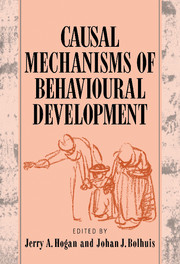Book contents
- Frontmatter
- Contents
- List of contributors
- Foreword: Introducing Jaap Kruijt
- Preface
- Part one Introduction
- Part two Development of perceptual and motor mechanisms
- 3 The neural basis for the acquisition and production of bird song
- 4 Sexual imprinting as a two-stage process
- 5 The influence of social interactions on the development of song and sexual preferences in birds
- 6 Perceptual mechanisms in imprinting and song learning
- 7 The development of action patterns
- Part three Development of behaviour systems
- Part four Development of cognition
- Part five Learning and development
- Author index
- Subject index
3 - The neural basis for the acquisition and production of bird song
Published online by Cambridge University Press: 19 January 2010
- Frontmatter
- Contents
- List of contributors
- Foreword: Introducing Jaap Kruijt
- Preface
- Part one Introduction
- Part two Development of perceptual and motor mechanisms
- 3 The neural basis for the acquisition and production of bird song
- 4 Sexual imprinting as a two-stage process
- 5 The influence of social interactions on the development of song and sexual preferences in birds
- 6 Perceptual mechanisms in imprinting and song learning
- 7 The development of action patterns
- Part three Development of behaviour systems
- Part four Development of cognition
- Part five Learning and development
- Author index
- Subject index
Summary
Avian song has received extensive attention, both as a natural behavior that is easily studied and can be related to ecology or to principles of natural selection, and as a neuroethological preparation in which it is possible to determine the neural basis for a complex motor activity in a vertebrate. This chapter is a survey of some of the central findings in both domains. It concentrates on the development of song and of brain regions that are responsible for song. It attempts to relate the behavioral and neurobiological findings in this system to more general issues of the nature of early perceptual and motor development and juvenile learning. In addition, it attempts to extend ideas on behavioral development to the neurobiological substrate for this behavior.
Overview of singing behavior
Acquisition of song – the perceptual phase
Several key findings are central to understanding avian song acquisition and performance. First, many features of song are learned. Thus, for example, many of the sounds comprising a canary's song closely resemble songs heard by the bird as a juvenile, and are distinct from sounds produced by other canaries (Marler & Waser, 1977, Waser & Marler, 1977). Zebra finches form a song by splicing elements of the songs of several individuals that they heard as juveniles, apparently favoring adults which had fed or interacted with them (Williams, 1990a). Similarly, nightingales form an elaborate song repertoire by acquiring and retaining ‘packages’ of sounds as a juvenile (Hultsch & Todt, 1989b), and swamp sparrows form a song by selecting from songs heard when young (Marler & Peters, 1988a).
- Type
- Chapter
- Information
- Causal Mechanisms of Behavioural Development , pp. 49 - 81Publisher: Cambridge University PressPrint publication year: 1994
- 17
- Cited by



